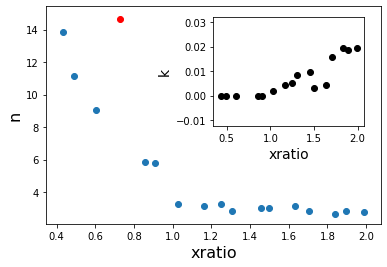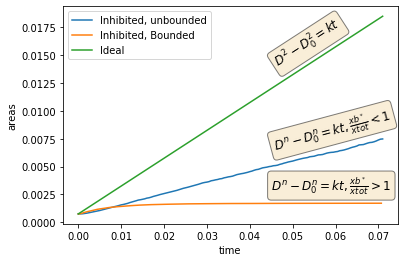Projects
Augmenting the feature vector for material design through analysis of grain growth
Software tools used
- Surface Evolver
- Mathematica
Python Libraries Used
- Matplotlib
Techniques Used
- Voronoi Tesselation
Graphical Summary

Description
Material design for nanocrystalline applications, focusing towards a particular stable grain size, is an emerging field. Focus has largely been on alloy selection based on enthalpy of solute segreation to the grain boundaries(1, 2). This work brings to light a new parameter, Xratio, that can potentially be used for improved alloy designing.
Xratio is defined to be Xbulk*/Xtotal. Xbulk* is the bulk mole fraction of the solute that corresponds to a theoretical zero value of the grain boundary energy. Xtotal is the total mole fraction of the solute in the entire alloy. While the former depends on material parameters such as the enthalpy of solute segregation, T, and grain boundary energy of the pure solvent, the latter is a microstructural parameter that depends only on the average grain size of the material. Essentially, Xratio combines both material parameters and microstructural parameters into one compact parameter. As seen in the image in graphical summary above and in the figure below, Xratio not only influences the steady state grain size, but also influences the n-exponent of the grain growth.
We investigate the kinetic regimes of solute segregation inhibited grain growth under the condition of dynamic solute redistribution between the grain boundaries and the bulk.Langmuir-Mclean’s analytical framework is adopted to model solute equilibrium between grain boundaries and the bulk, and the Gibbs adsorption isotherm is used to model the dependence of the grain boundary energy on the solute mole fraction. The inhibition of grain growth is incorporated in the model through a segregation-induced reduction in the grain boundary interfacial energy. Two-dimensional numerical simulations, performed by implementing this model within the framework of Surface Evolver, are used to validate predictions from the analytical framework and provide insights into the kinetic behavior of alloy systems under the given conditions. Under the stated assumptions, two different regimes of grain growth are identified depending on the steady state value of X-bulk. When X-bulk is asymptotic to X-bulk* , grain growth is completely impeded, whereas when it is asymptotic to X-tot, the total mole fraction of solute in the material, grain growth continues unimpeded.

Predicting later-time grain stability based on initial topographical data
Python Libraries Used
- Scikit-Learn
- Pandas
- Numpy
Techniques Used
- Data Cleaning
- Feature Engineering
- Classifiers - Random Forest, Decision Trees, 1D-CNN
Code repository
https://github.com/ArunBaskaran/DS-Projects/GrainStability
Description
To be Updated